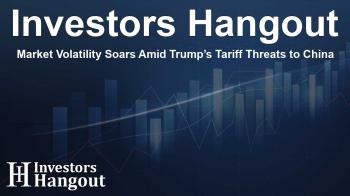Market Volatility Soars Amid Trump’s Tariff Threats to China

Market Reaction to Tariff Threats
On a dramatic Friday, Wall Street's stable ascent was abruptly halted as uncertainty grew over renewed tariff threats from President Donald Trump towards China. These unexpected moves triggered a wave of panic among investors, leading to a substantial sell-off in various risk assets and a significant drop in equity valuations, particularly within technology sectors.
The Surge in Market Volatility
The CBOE Volatility Index (VIX), often viewed as Wall Street's fear barometer, witnessed a remarkable spike of 25% by mid-afternoon in New York, marking the largest single-day surge in months. This rise in volatility reflected the growing concern among traders and investors about potential economic implications stemming from escalating trade tensions.
Indices Reflecting Major Declines
The S&P 500, as tracked by the Vanguard S&P 500 ETF (NYSE: VOO), experienced a notable downturn, declining by 1.8%. This was poised to be its steepest one-day drop since April. Similarly, the Nasdaq 100 recorded an even sharper fall of 2.2%, indicating a concerning trend for growth-oriented stocks.
Key Players Taking Hits
Major tech companies were not spared from the wrath of the market’s turbulence. Names like Arm Holdings plc (NASDAQ: ARM), led the losses with a staggering 8% drop. The traditional powerhouse, the Dow Jones Industrial Average, also slid by 1.2%, compounding fears across the entire market.
The Impact on Tech Giants
These events hit particularly hard for the Magnificent Seven, a group of elite tech stocks that collectively lost over $500 billion in market capitalization. Notably, Nvidia Corp. (NASDAQ: NVDA) faced the brunt of this decline, accounting for around $200 billion of the lost value, as its market cap tumbled down to approximately $4.57 trillion.
Drop in Major Market Players
Other tech giants like Microsoft Corporation (NASDAQ: MSFT) and Apple Inc. (NASDAQ: AAPL) also faced declines of 1.51% and 2.34% respectively, showcasing the widespread nature of this downturn. Alphabet Inc. (NASDAQ: GOOGL) and Amazon.com, Inc. (NASDAQ: AMZN) saw similar setbacks, further reinforcing the overall negative sentiment in the tech sector.
2025 High Flyers Crashing
Interestingly, some of the year's top-performing stocks, labeled as the 'high flyers', took considerable hits as well. For example, Robinhood Markets Inc. (NASDAQ: HOOD), the standout performer in the S&P 500 for 2025, saw a drop of 6% during this tumultuous trading session, marking its worst performance in six months.
Mood Among Investors
As sector performance shows, NIO Inc. (NYSE: NIO) and Alibaba Group Holding Ltd. (NYSE: BABA) also registered significant losses in New York trading among Chinese equities, contributing to overall negative market sentiment.
Sector-Specific Reactions
Additionally, commodities felt the pressures from the unfolding market dynamics. WTI crude oil unexpectedly fell more than 4% to $59 per barrel, hitting its lowest benchmark in five months, while natural gas prices dropped by 4.5%.
Stability in Precious Metals
On a contrasting note, precious metals mirrored a more stable stance with Silver maintaining prices above $50 an ounce, while Gold edged slight gains, hovering just below the crucial $4,000 mark.
Crypto Markets Reacting Similarly
Even the cryptocurrency sphere was not immune to the market's drastic maneuvers. Bitcoin (CRYPTO: BTC) slid by 3% to $117,000, amid an ongoing downtrend, reflecting the intertwined nature of these markets.
Implications of Potential Trade War
Analysts warn that if tensions continue to escalate, we may witness long-term implications for economic growth and trade relations worldwide. Investors remain on high alert as they watch for any further announcements that could shift market dynamics.
Frequently Asked Questions
What triggered the market volatility recently?
President Trump’s renewed tariff threats against China were the primary cause, sparking fear among investors and leading to significant declines in tech sectors.
How did the VIX change during this period?
The VIX surged by 25%, indicating heightened market fear and uncertainty among investors.
Which sectors were most affected by the market downturn?
The technology sector was notably affected, with major tech companies experiencing substantial losses in market capitalization.
What are the potential long-term implications of these tariffs?
Potential long-term consequences could include slowed economic growth and increased tension in international trade relations.
Will these developments affect cryptocurrencies?
Yes, the heightened market volatility typically affects all asset classes, including cryptocurrencies, which have also seen declines amid this uncertainty.
About The Author
Contact Caleb Price privately here. Or send an email with ATTN: Caleb Price as the subject to contact@investorshangout.com.
About Investors Hangout
Investors Hangout is a leading online stock forum for financial discussion and learning, offering a wide range of free tools and resources. It draws in traders of all levels, who exchange market knowledge, investigate trading tactics, and keep an eye on industry developments in real time. Featuring financial articles, stock message boards, quotes, charts, company profiles, and live news updates. Through cooperative learning and a wealth of informational resources, it helps users from novices creating their first portfolios to experts honing their techniques. Join Investors Hangout today: https://investorshangout.com/
The content of this article is based on factual, publicly available information and does not represent legal, financial, or investment advice. Investors Hangout does not offer financial advice, and the author is not a licensed financial advisor. Consult a qualified advisor before making any financial or investment decisions based on this article. This article should not be considered advice to purchase, sell, or hold any securities or other investments. If any of the material provided here is inaccurate, please contact us for corrections.

